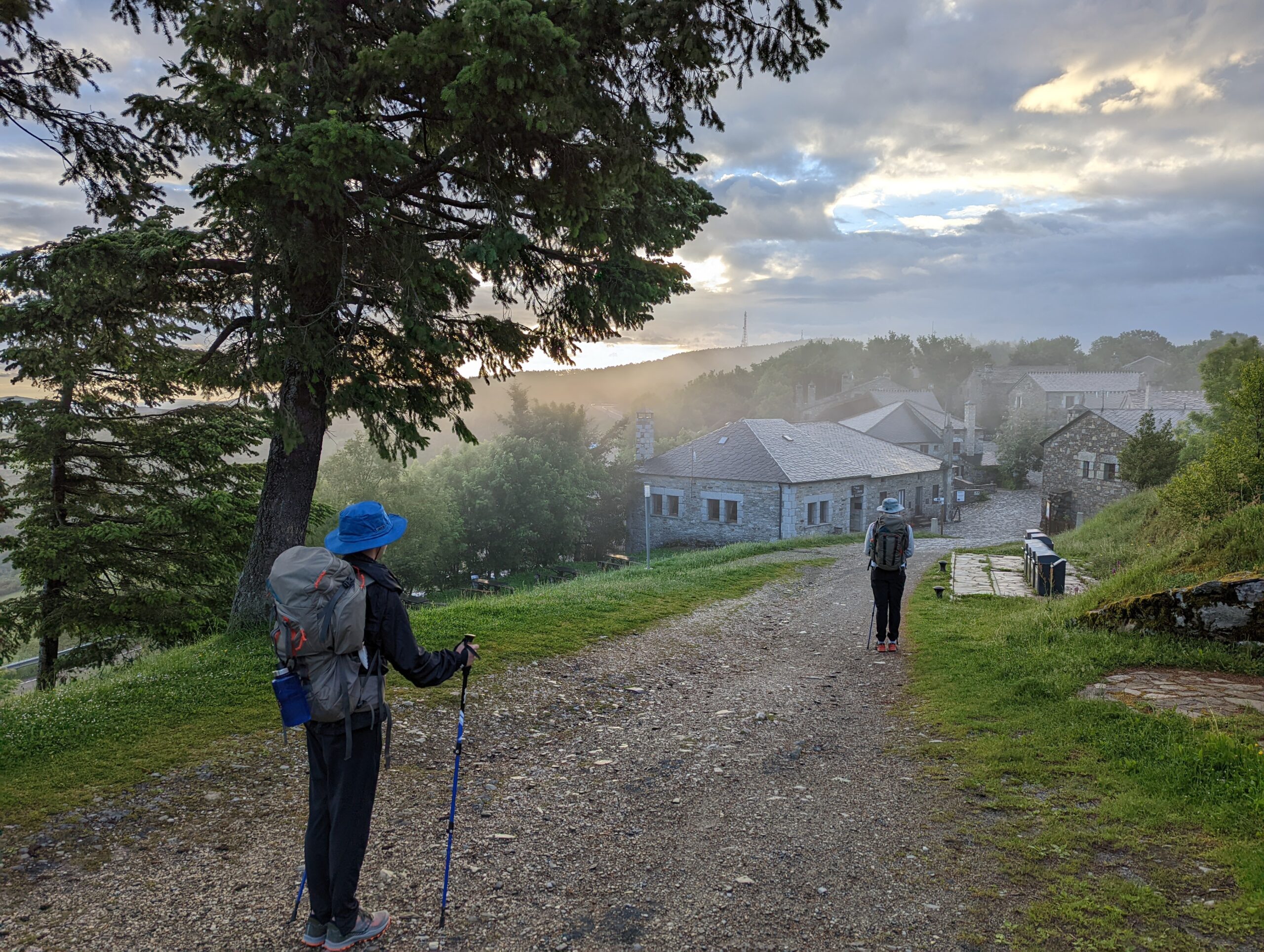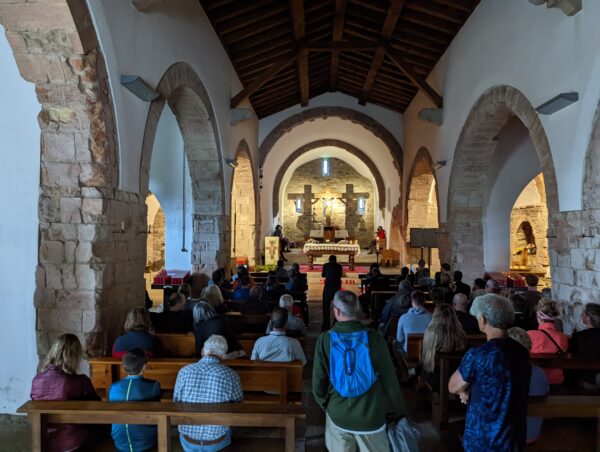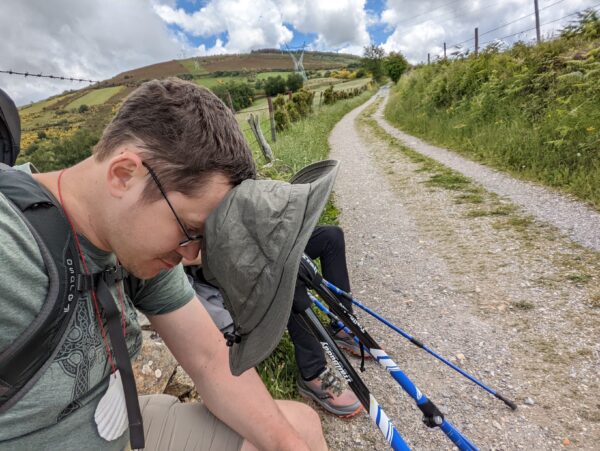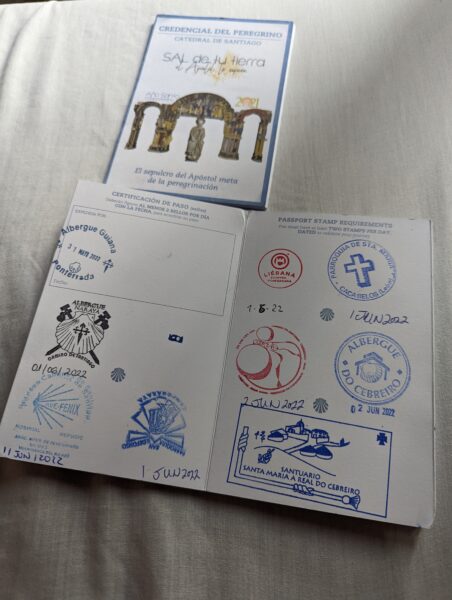
Walking El Camino, Alone & Together
Michael Donlan ’99 and his two sons, John ’25 and Andrew ’26, students at Pius X, walked ‘El Camino de Santiago’ last summer. The Camino de Santiago, also known as the Way of St. James, is a physical and spiritual journey following a path of medieval origin in Spain. The trek can take up to six weeks or fewer depending on starting point and pace. Michael provided insight into the journey with this post-trip thoughts, as well as excerpts from his journal.
Michael Donlan: This is the brainchild of my brother-in-law, Al Jirak. He married my wife’s sister (Teresa Gfeller of the Pius X class of 2000). We visited Al and Teresa at their home in Wichita for Thanksgiving 2021. Al took his three eldest boys on the Camino from Pamplona to Santiago de Compostela over about five weeks in the summer of 2021. He proposed taking a large group of fathers and sons in 2022. We joined the group.
In addition to us, a father and son from Omaha, a boy from North Carolina, his dad and grandpa, joined two priests of the Diocese of Wichita and fathers and sons from Wichita on the trip. In total, there were 32 of us: 16 sons, 14 dads, Fr. Chad Arnold and Fr. Chris Rumback. The Camino has been on my bucket list, but I don’t know when I would have gone if it wasn’t for the prompting of my brother-in-law.
 May 31 – After we landed, we took five-hour bus ride to Ponferrada. Beautiful countryside. Ponferrada is known for this castle built by the Knights Templar in the 12th century. They were formed during the first crusade to protect pilgrims traveling to the holy land. The bishop of Astorga and the Spanish king brought them here to protect those walking the Camino de Santiago. Much was rebuilt in the 15th century. It was pretty amazing to see.
May 31 – After we landed, we took five-hour bus ride to Ponferrada. Beautiful countryside. Ponferrada is known for this castle built by the Knights Templar in the 12th century. They were formed during the first crusade to protect pilgrims traveling to the holy land. The bishop of Astorga and the Spanish king brought them here to protect those walking the Camino de Santiago. Much was rebuilt in the 15th century. It was pretty amazing to see.
June 1 – Villafranca del Bierzo, Spain: Feet are tired. First blisters have formed. We veered off by mistake so took a bit longer hilly route. As my feet were sore and I anxiously awaited the end, I thought of St. James traveling this way…without a bus ride, REI shoes and a nice pack. A peregrino told me to apply Vaseline to my feet before applying my socks, so we went to the Farmacia and bought Vasolina. The walk was beautiful.We celebrated Mass in the parish church here. Andrew read the reading. It was built in 1186.
June 3 – O Cebreiro, Galicia, Spain: Why ease into it?! It is interesting how, both literally and figuratively, sometimes what one thinks is an easy road can turn out to be more difficult in the end. Approximately half of our journey on Thursday was on a paved road. At first, this seemed easy. Nice and smooth. Don’t have to worry about mud or rocks. As the day went on, an eight-hour walk (our longest of the journey), my feet got sore as expected (blister count increased from two to three, but the mole skin and Vaseline are paying off), but my right Achilles just burned. Paved road is hard on your feet! The end was a pretty dramatic climb upward. This was much easier on my feet and thankfully was much easier for Andrew. However, the climb was a struggle for me mainly due to my bit of tendonitis. As my brother-in-law said, each person’s experience is different and we don’t need to stay as a group, take our time. John is doing great and went ahead. We took some nice breathers.
June 3 – Triacastela, Galicia, Spain: 19th Century Ugandan martyr St. Charles Lwanga and his companions were burnt at the stake for remaining Christian in defiance of the king. Nowhere near as dramatic, I recall the pain and suffering I worked through today. Downhill may seem easy, but it has its challenges. The shady trail towards the end was very muddy. I grew frustrated that I could not avoid the mud and that made the anticipation of the end and it not coming soon enough more difficult to deal with. I got mad and irritated for the first time on this trip. On top of that, the ace wrap that was helping now seems to be hurting. I again remember the many pilgrims who did this without my tools. I also remember the kids I see doing this and the gray-haired ladies I met today from Paris and Ireland doing this.
 June 4 – Otero De Rey, Spain: Andrew decided that the inserts made his shoes feel too tight. However, I loved them and they reduced my foot pain. I did not have to wrap my ankle today. One blister is gone. I am still covering the other two. One is intact and one is broken. Two experiences today remind me not to take anything for granted. After hearing about each person’s unique journey, the thing I enjoy the most about RCIA is hearing people’s different perspectives on faith and Catholic religious practice. Along with my experience as a home health nurse, my experience from kindergarten through seminary has shaped how I see the world. According to Erik Erikson, I am in the generativity vs. stagnation stage of development. During this stage, middle-aged adults strive to create or nurture things that will outlast them, often by parenting children or fostering positive changes that benefit others. Contributing to society and doing things to promote future generations are important needs at this stage. Kathy (my wife) and I make a point to make sure the kids understand why we do what we do.
June 4 – Otero De Rey, Spain: Andrew decided that the inserts made his shoes feel too tight. However, I loved them and they reduced my foot pain. I did not have to wrap my ankle today. One blister is gone. I am still covering the other two. One is intact and one is broken. Two experiences today remind me not to take anything for granted. After hearing about each person’s unique journey, the thing I enjoy the most about RCIA is hearing people’s different perspectives on faith and Catholic religious practice. Along with my experience as a home health nurse, my experience from kindergarten through seminary has shaped how I see the world. According to Erik Erikson, I am in the generativity vs. stagnation stage of development. During this stage, middle-aged adults strive to create or nurture things that will outlast them, often by parenting children or fostering positive changes that benefit others. Contributing to society and doing things to promote future generations are important needs at this stage. Kathy (my wife) and I make a point to make sure the kids understand why we do what we do.
June 5 – Lugo, Spain: Sunday was kind of a journey from darkness to light. I quickly just got irritated. I was tired of the monotony….uphill, downhill, rocks, mud, manure, cyclists breezing past unexpectedly .. onward, onward, onward. My wife will attest that I start ruminating when I get annoyed. Now, it is this, stuff at home, things out of my control, even things that my imagination makes up. It just grows and grows. I met a young lady from Boston a few days ago. She is walking after she finished a teaching job in France. She is on day 28 and her brother just joined her a few days ago. The Camino becomes a community as we see each other here and there along the way….A pilgrim must complete at least 100 kilometers in order to receive a certificate in Santiago de Compostela, so Sarria is a popular starting point. We went from a lot of solitude to barely under 10 people at any given time around us today. I think that bothered me, too. After the break, the boys went up ahead and I did get some alone time while others took breaks. I then met Javier and Pam from Mexico but now in Michigan. They were a delightful young couple who just started today. They are doing this to help process the recent death of her dad.
 June 6 – Palas Del Rey, Galacia, Spain: This was a really nice day. None of us had any issues other than sore feet which are always with us. I just can’t be thankful enough for the beautiful weather. The skies have been partly to mostly cloudy and it has only rained hard. Once. Today, we walked through a light misty rain for quite a while, but I don’t mind. As long as it is cool. The sun came out right as we hit our destination. Father Chad gave us a talk this evening about the saying “It is your Camino”. We hear this a lot. Basically, it just means that each person has a unique experience. … He challenged us to not disregard that as a trite sentiment, but rather, meditate on what God is doing to each of us through this journey. He reminded us to not get distracted by the common temptation to compare ourselves to others. I am not as wealthy as that person. I don’t have a relationship with my son like he does. I don’t have that person’s gifts. Rather, God has given each person gifts and challenges that are for him alone; that helps make Him Him.
June 6 – Palas Del Rey, Galacia, Spain: This was a really nice day. None of us had any issues other than sore feet which are always with us. I just can’t be thankful enough for the beautiful weather. The skies have been partly to mostly cloudy and it has only rained hard. Once. Today, we walked through a light misty rain for quite a while, but I don’t mind. As long as it is cool. The sun came out right as we hit our destination. Father Chad gave us a talk this evening about the saying “It is your Camino”. We hear this a lot. Basically, it just means that each person has a unique experience. … He challenged us to not disregard that as a trite sentiment, but rather, meditate on what God is doing to each of us through this journey. He reminded us to not get distracted by the common temptation to compare ourselves to others. I am not as wealthy as that person. I don’t have a relationship with my son like he does. I don’t have that person’s gifts. Rather, God has given each person gifts and challenges that are for him alone; that helps make Him Him.
June 7 – Arzúa, Spain: Today was a long day as we are making up some ground today and tomorrow so that Thursday is just a two-hour walk which will allow us to get to the pilgrimage office before Mass at the cathedral in Santiago de Compostela. It was American day as pretty much all of the people I met or saw again were American… Boston, LA, Utah, Connecticut, Queens, Chicago. I added another country to the list … BTW, the boys are feeling good, no blisters for them and no new ones for me. Feet are just sore. I now know what athletes mean by hurt versus injured. Our feet hurt, but are not injured.
June 9 – El Pino, Spain: The fifth mystery of the rosary is the finding of Jesus in the temple. That will mean a lot more to me now. On our Wednesday journey, John got farther ahead of us and I did not give him any money to eat so I hustled up to trying catch up to him so we could stop and wait for Andrew. After walking for some time, I decided that if he really wanted to eat he would stop and wait. So I waited for Andrew in O Pedrouzo. It is a fairly good sized town which we skirted to the north. I decided to wait there for Andrew so that he did not get confused with the different streets. I started to backtrack when I was not seeing many pilgrims. The pilgrims started to come. I chatted with some people. About 30 minutes passed; I did not think I was that far ahead of him. One of our group told me that there was some confusion a bit of the way back at the highway crossing as some people headed into town and did not see the marker indicating that the path went down a dirt trail. I thought Andrew may have gone through town and gotten around me. So I hauled for about 30 minutes. I was worried about him. I wondered what I would do if he was not ahead of me. “Jesus, I trust in you.” I then figured that Andrew knew to look for the markers and could ask anyone where the Camino was if he got lost and they would point the direction. My understanding of Jesus getting lost is that people would travel in a caravan so it was not unusual to split up. The Camino is similar. I figured that the Camino would keep him safe. He would find the way or find people who would show him the way. I ended up chasing him down much to his and my relief. John had gotten far ahead because he was pacing my brother-in-law. They were praying the rosary and John told me that he had a feeling that he should be praying for me.
June 9 – Santiago de Compostela, Spain: Finished! 234.4 km which is roughly 145 miles…like from Lincoln to just shy of Kearney. It was an interesting feeling. Many of us agreed that the Camino was so directed towards Santiago, but once we entered the city of roughly 130,000, navigating through the streets, we were thrust back into the everyday secular world seemingly oblivious to the Camino (both internal and external journey). This muted the feeling entering the square. For many of us, however, the Mass brought us back to just how special this is. Strangers just two weeks ago, we enjoyed each other’s company and shared reflections while sitting in the large green park in front of the seminary overlooking the city before we went our separate ways over the next couple of days. Our experiences were individual, within our family, and within our larger Camino family. It was a wonderful experience.
 The Start, Stamps and Stays: Each pilgrim (peregrino in Spanish) purchases a credential at the beginning of the Camino, wherever that may be. We have to get at least 2 stamps per day in order to receive a compostela in Santiago. This is very easy to obtain. In fact, it is easy to run out of room as most churches and businesses offer stamps along the way. The stamps show that you are progressing along the Camino. In Santiago de Compostela, peregrinos are asked if they completed the pilgrimage for spiritual reasons or not. Those completing the Camino for spiritual reasons, who have traveled at least 100 km, and have at least 2 stamps per day receive a compostela. If they completed the Camino for another reason like just for pleasure, the peregrino can purchase a certificate indicating that they completed the Camino. There are many Caminos originating throughout Spain and Portugal. They all end up in Santiago de Compostela. The traditional route goes from St. Jean-Pie-du-Port across the Pyrenees in France. It then crosses northern Spain. This can take up to 6 weeks to travel. We started in Ponferrada so that we could experience some of the variety of the Camino, but still complete the journey in under 10 days as it is hard to get away for an extended period of time as an American. There are hostels along the way that are specifically for the pilgrims. These are called albergues. They vary in quality. We stayed in one that was a bit rustic; the showers were cold. Most were very modern, provided a laundry room, and offered warm showers. The beds were dormitory style. There would be men and women in the same albergue, but I never got the sense that anyone felt unsafe along the Camino.
The Start, Stamps and Stays: Each pilgrim (peregrino in Spanish) purchases a credential at the beginning of the Camino, wherever that may be. We have to get at least 2 stamps per day in order to receive a compostela in Santiago. This is very easy to obtain. In fact, it is easy to run out of room as most churches and businesses offer stamps along the way. The stamps show that you are progressing along the Camino. In Santiago de Compostela, peregrinos are asked if they completed the pilgrimage for spiritual reasons or not. Those completing the Camino for spiritual reasons, who have traveled at least 100 km, and have at least 2 stamps per day receive a compostela. If they completed the Camino for another reason like just for pleasure, the peregrino can purchase a certificate indicating that they completed the Camino. There are many Caminos originating throughout Spain and Portugal. They all end up in Santiago de Compostela. The traditional route goes from St. Jean-Pie-du-Port across the Pyrenees in France. It then crosses northern Spain. This can take up to 6 weeks to travel. We started in Ponferrada so that we could experience some of the variety of the Camino, but still complete the journey in under 10 days as it is hard to get away for an extended period of time as an American. There are hostels along the way that are specifically for the pilgrims. These are called albergues. They vary in quality. We stayed in one that was a bit rustic; the showers were cold. Most were very modern, provided a laundry room, and offered warm showers. The beds were dormitory style. There would be men and women in the same albergue, but I never got the sense that anyone felt unsafe along the Camino.
The People You Meet: To put it simply, the trip was wholesome. It fed the whole person. The walking provided physical exercise. The people and scenery of the Camino were beautiful. The pace allows for reflection, prayer, and community. We met so many interesting people. Pilgrims walk the Camino for many reasons. We met people processing life events like the death of a family member. We met people trying to find their way in life. We also met people simply walking the Camino with friends for pure enjoyment. We loved the history of the Camino and the beautiful, historic Catholic churches along the way. It was an expression of faith for me; a microcosm of the spiritual journey. It contained challenges and consolations. Experiencing these things as a community brought a sense of brotherhood which brought us all together. Once, I explained to a non-Catholic how I love being Catholic. I told her that I don’t see the Church as something that gets in the way, but rather as an avenue through which I encounter Christ. The Camino was much like this. The journey was individual. Some of the experiences and thoughts are unable to be adequately shared; they are just for me. However, the journey is also communal. I helped others along the way and they helped me. The Church, my family in both a spiritual and temporal way, aids me in my journey. We approach God both individually and as a community. Buen Camino!


